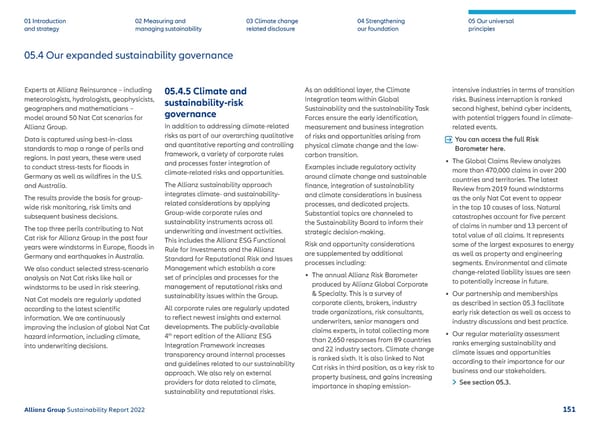05.4 Our expanded sustainability governance 01 Introduction and strategy 02 Measuring and managing sustainability 03 Climate change related disclosure 04 Strengthening our foundation 05 Our universal principles Experts at Allianz Reinsurance – including meteorologists, hydrologists, geophysicists, geographers and mathematicians – model around 50 Nat Cat scenarios for Allianz Group. Data is captured using best-in-class standards to map a range of perils and regions. In past years, these were used to conduct stress-tests for floods in Germany as well as wildfires in the U.S. and Australia. The results provide the basis for group- wide risk monitoring, risk limits and subsequent business decisions. The top three perils contributing to Nat Cat risk for Allianz Group in the past four years were windstorms in Europe, floods in Germany and earthquakes in Australia. We also conduct selected stress-scenario analysis on Nat Cat risks like hail or windstorms to be used in risk steering. Nat Cat models are regularly updated according to the latest scientific information. We are continuously improving the inclusion of global Nat Cat hazard information, including climate, into underwriting decisions. 05.4.5 Climate and sustainability-risk governance In addition to addressing climate-related risks as part of our overarching qualitative and quantitative reporting and controlling framework, a variety of corporate rules and processes foster integration of climate-related risks and opportunities. The Allianz sustainability approach integrates climate- and sustainability- related considerations by applying Group-wide corporate rules and sustainability instruments across all underwriting and investment activities. This includes the Allianz ESG Functional Rule for Investments and the Allianz Standard for Reputational Risk and Issues Management which establish a core set of principles and processes for the management of reputational risks and sustainability issues within the Group. All corporate rules are regularly updated to reflect newest insights and external developments. The publicly-available 4 th report edition of the Allianz ESG Integration Framework increases transparency around internal processes and guidelines related to our sustainability approach. We also rely on external providers for data related to climate, sustainability and reputational risks. As an additional layer, the Climate Integration team within Global Sustainability and the sustainability Task Forces ensure the early identification, measurement and business integration of risks and opportunities arising from physical climate change and the low- carbon transition. Examples include regulatory activity around climate change and sustainable finance, integration of sustainability and climate considerations in business processes, and dedicated projects. Substantial topics are channeled to the Sustainability Board to inform their strategic decision-making. Risk and opportunity considerations are supplemented by additional processes including: • The annual Allianz Risk Barometer produced by Allianz Global Corporate & Specialty. This is a survey of corporate clients, brokers, industry trade organizations, risk consultants, underwriters, senior managers and claims experts, in total collecting more than 2,650 responses from 89 countries and 22 industry sectors. Climate change is ranked sixth. It is also linked to Nat Cat risks in third position, as a key risk to property business, and gains increasing importance in shaping emission- intensive industries in terms of transition risks. Business interruption is ranked second highest, behind cyber incidents, with potential triggers found in climate- related events. You can access the full Risk Barometer here. • The Global Claims Review analyzes more than 470,000 claims in over 200 countries and territories. The latest Review from 2019 found windstorms as the only Nat Cat event to appear in the top 10 causes of loss. Natural catastrophes account for five percent of claims in number and 13 percent of total value of all claims. It represents some of the largest exposures to energy as well as property and engineering segments. Environmental and climate change-related liability issues are seen to potentially increase in future. • Our partnership and memberships as described in section 05.3 facilitate early risk detection as well as access to industry discussions and best practice. • Our regular materiality assessment ranks emerging sustainability and climate issues and opportunities according to their importance for our business and our stakeholders. See section 05.3. > 151 Allianz Group Sustainability Report 2022
 Sustainability Report 2022 | Allianz Page 151 Page 153
Sustainability Report 2022 | Allianz Page 151 Page 153